Qatara area: plants in late October
Qatara area: plants in late October
by Geoff SandersonLate Octoberís weather is a relief to most plants that have, over the last five months, been able to do little more than survive the intense heat of summer. Good rainfalls this year plus the kinder weather has produced considerable celebratory growth.
The wadis east of Jebel Qatara and the broad, fertile alluvial plains are awash with sage green Haloxylon salicornicum (syn Hammada elegans). In a few weeks time these plants will be blush pink or amber, covered in transparent flowers, quite a spectacle with the sunlight behind them.
The ubiquitous Sodomís Apple, Calotropis procera, was happy to show how it can ignore seasons and readily produce flowers, fruit and dried seed all at the same time.
Click on photo for larger image; may take several seconds for those with 56k modem
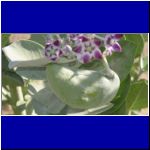
Sodomís Apple (Calotropis procera) with flower and fruit

Haloxylon salicornicum (sage coloured plant), Acacia tortillis being browsed by camel; Lycium shawii (the dark green bush behind the camel) and a Sidr Tree (Zizyphus spina Christi).

Acacia tortillis amongst Haloxylon salicornicum Ghaf trees, Prosopis cineraria, also have fresh olive green foliage.
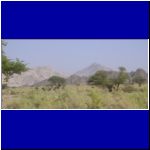
Ghaf Trees (Zyziphus spina-christi) silhouetted against the sky and the pastel shades of the distant Hajar Mountains.
The group was quite taken by the curly, dried, grassy leaves of the, for all intents and purposes, dead tussocks of Cymbopogon schoenanthus, Incense Grass. Not dead, just sleeping; as soon as we get some winter rain, or just cooler weather, it will come alive and wave its grassy flowers in the breeze.
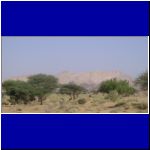
Cymbopogon schoenanthus, Incense Grass. Below, deep green Acacia tortillis (Samr), bright green Zyziphus spina-christi (Sidr) and the odd camel topiaried Lycium shawii scatter amongst the Haloxylon.
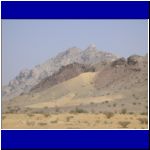
Lycium shawii shaped by camelís with the designersí eye
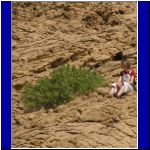
The Caper plant (Caparis spinosa) with admirer, clinging to the stark limestone cliffs.
Note: I am hoping to collect some seed from the more common plant species and use it for land regeneration projects and for the Arabian section of the redeveloping Al Ain Zoo. The quantities of seed we are talking about will be miniscule compared with the total seed bank of the region.